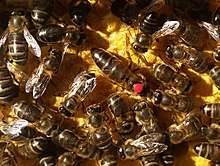Apis mellifera intermissa
Apis mellifera intermissa is an African subspecies of the western honey bee.
| Apis mellifera intermissa | |
|---|---|
 | |
| Scientific classification | |
| Kingdom: | Animalia |
| Phylum: | Arthropoda |
| Class: | Insecta |
| Order: | Hymenoptera |
| Family: | Apidae |
| Genus: | Apis |
| Species: | A. mellifera |
| Subspecies: | A. m. intermissa |
| Trinomial name | |
| Apis mellifera intermissa (Buttel-Reepen, 1906) | |
| Synonyms[1] | |
|
Apis mellifera major | |
Description
Previously classified as A. m.intermissa v. Buttel-Reepen[2][3][4] a reviewed classification of genus instead states the sub-species as A. m. intermissa v. Maa (M. S. Engel 1999)[5][6] Found in the south of Spain [7] and the (Maghreb) north of the Sahara desert in Africa, ranging from the east (Libya) to the west (Morocco),[8][9] and is adapted to dry climates.[10] This bee has a black-brown and orange striated abdomen and black-brown thorax with orange fur.[11][12][13][14]
Taxonomy
In a comparative study of five subspecies and A. m. iberica (Smith, Palopoli, Taylor, Garnery, Cornuet, Solignac, Brown 1991) cleavage maps obtained through the use of restriction enzymes [15] showed that the Spanish honey bee contains mtDNA similar to intermissa and also mellifera.[7] Additionally, A. m. intermissa belongs to a group shown by experiment to have similar mtDNA (mitochondrian DNA), this including monticola, scuttelata, adansonii and capensis [16][17][18]
In Spanish honey bee populations, mtDNA haplotypes of African bee strains were found to be frequently present (Smith 1991, Garnery et al 1995) (Cornuet et al 1975, 1978, 1982, 1988; Ruttner 1988; Cornuet and Fresnaye 1989; Orante-Bermejos and Garcia-Fernandez 1995; Hepburn and Radloff 1996). Migrating honey bee populations formed the original colonies of honey bees in western Europe, landing to eventually populate the continent from Africa across the Straits of Gibraltar.[19]
See also
References
- Michael S. Engel (1999). "The taxonomy of recent and fossil honey bees (Hymenoptera: Apidae: Apis)". Journal of Hymenoptera Research. 8: 165–196.
- "Honey bee breeds". save-bee.com. Retrieved 2013-06-07.
- "Honey bees". Retrieved 2018-05-11.
- Encyclopedie Universelle de la Langue Francaise – Abeilles – Apidae – Apis Mellifera – Introduction. encyclopedie-universelle website. Retrieved 2013-06-07.
- M. S. Engel google.co.uk The Taxonomy of Recent and Fossil Honey Bees (Hymenoptera :Apidae , Apis) J.HYM RES Vol 8(2) 1999 p.165-196 [Retrieved 2011-12-20]
- Advances in Insect Physiology. Academic Press. 1994. p. 131. ISBN 978-0-08-057921-4.
- D. R. Smith, M. F. Palopoli, B. R. Taylor, L. Garnery, J.-M. Cornuet, M. Solignac, W. M. Brown Geographical Overlap of Two Mitochondrial Genomes in Spanish Honeybees (Apis mellifera iberica) The Journal of Heredity. Oxford University Press 03/01/1991. Retrieved 2011-12-19.
- apiconsult.com website (Apiconsult 2006) a website dedicated to aiding and improving the livelihoods of people within Africa [Retrieved 2011-12-19]
- Mark L. Winston books.google.co.uk The biology of the honey bee (281 pages) Harvard University Press, 1 Apr 1991 ISBN 0-674-07409-2 [Retrieved 2011-12-19]
- "Honey bees".
- Leen van 't Leven, Marieke Mutsaers, Piet Segeren, Hayo Velthuis books.google.co.uk AD32E Beekeeping in the tropics Agromisa Foundation[Retrieved 2012-12-19]
- David Wynick University of Bristol [2nd Apr 2008] from askabiologist.org.uk website
- "Netzwerk Biene". honey-bees.de. Retrieved 7 May 2015.
- Jalel l'apiculteur flickr.com [Retrieved 2011-12-20]
- "Restriction Maps". colostate.edu. Archived from the original on 2015-11-01. Retrieved 7 May 2015.
- Garnery L, Cornuet J M, Solignac M (October 1992). "pubget.com". Evolutionary history of the honey bee Apis mellifera inferred from mitochondrial DNA analysis. Mol Ecol. 1 (3): 145–54. doi:10.1111/j.1365-294X.1992.tb00170.x. PMID 1364272.CS1 maint: multiple names: authors list (link)
- John E. Dews, Eric Milner books.google.co.uk Breeding Better Bees (80 pages) WritersPrintShop, 2004 ISBN 1-904623-18-2 [Retrieved 2011-12-19]
- M.Chouchene, N. Barbouche, M.Garnery, L.Baylac openstarts.units.it Nimis P.L. Vignes Lebbe R (eds.) Tools for Identifying Biodiversity: Progress and Problems p.343 Molecular and ecophysiological characterisation of the Tunisian bee: Apis mellifera intermissa ISBN 978-88-8303-295-0 EUT,2010[Retrieved 2011-12-20]
- Pierre Franck, Lionel Garnery, Michel Solignac and Jean-Marie Cornuet (1997) JSTOR The Origin of West European Subspecies of Honeybees (Apis mellifera): New Insights from Microsatellite and Mitochondrial Data EvolutionVol. 52, No. 4 (Aug., 1998), pp. 1119-1134 (article consists of 16 pages) Published by: Society for the Study of Evolution [Retrieved 2011-12-22]
External links
| Wikimedia Commons has media related to Apis mellifera intermissa. |